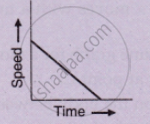Advertisements
Advertisements
प्रश्न
Given alongside is the velocity-time graph for a moving body :
Find :
(i) Velocity of the body at point C.
(ii) Acceleration acting on the body between A and B.
(iii) Acceleration acting on the body between B and C.

उत्तर
(i) BC represents uniform velocity. So velocity of the body at point C is 40 km
(ii) Acceleration = Slope of line AB
= `((40-20))/((3-0)) (km)/(hr^2)`
= 6.66 `"km/hr"^2`
(iii) BC represents uniform velocity, so, acceleration acting on the body is zero.
APPEARS IN
संबंधित प्रश्न
What does the slope of a speed-time graph indicate ?
Derive the following equation of motion by the graphical method : v2 = u2 + 2as, where the symbols have their usual meanings.
What type of motion is represented by the following graph ?

What type of motion is represented by the following graph ?

Draw displacement – time graph for the following situation:
When a body is stationary.
Its time-displacement graph is a straight line.
Draw distance-time graph to show:
Decreasing velocity
The area under velocity – time graph represents the ______
State whether true or false. If false, correct the statement.
The velocity – time graph of a particle falling freely under gravity would be a straight line parallel to the x axis.
A straight line parallel to the x-axis in the velocity-time graph represents the object moving in ______.
